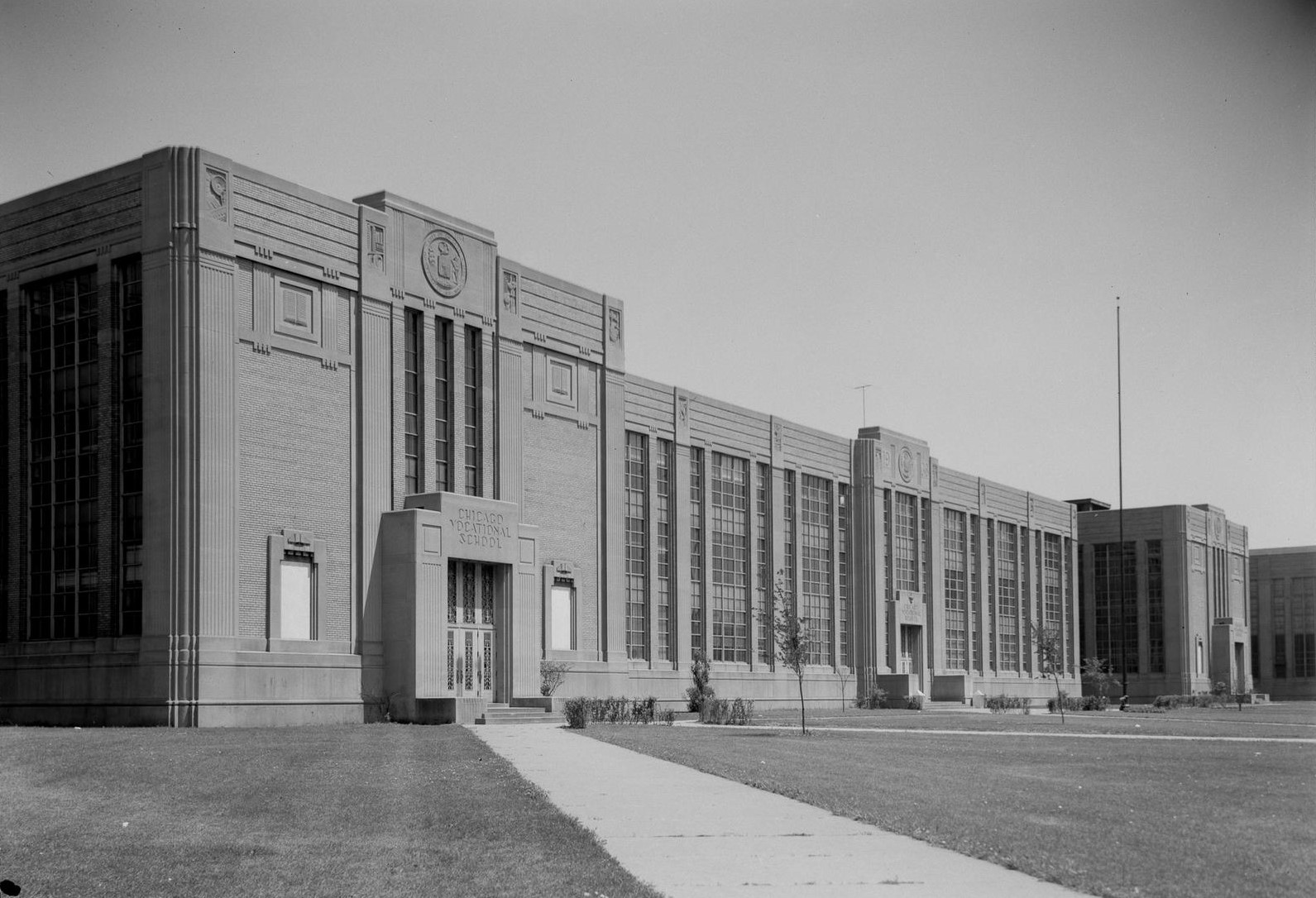Chicago Vocational School (CVS), a 2024 Chicago 7 Most Endangered, 1941, John Christensen, 2100 E. 87th Street. Photo Credit: Lee Bey










Chicago Vocational School (aka Chicago Vocational Career Academy)
Address: 2100 E. 87th Street
Architect: John C. Christensen
Date: 1938-1941
Style: Art Deco/Art Moderne
Neighborhood: Avalon Park
Overview
Chicago Vocational School (today, Chicago Vocational Career Academy but most commonly known as CVS) is among the most notable examples of Art Deco/Art Moderne architecture in the city of Chicago. It is also the largest such structure in Chicago that is not a downtown skyscraper. Constructed between 1938 and 1941, Chicago Vocational High School was intended as a southern counterpart to Albert G. Lane Technical College Preparatory High School (1908, 1934), more commonly known today as Lane Tech. A combination of generational demographic shifts, changes in urban educational philosophy, and federal financial support all led to the eventual creation of Chicago Vocational High School.
Beyond its sheer size– the school’s four principal structures sit on a 22-acre triangular parcel–the school is significant as a former site of wartime preparedness during WWII, an early and surviving Public Works Administration/Works Progress Administration-funded project in Chicago, and an Avalon Park institution that was once affectionately known as “The Pride of South Side.”
CVS is an active Chicago Public School, with a renewed emphasis on STEM (Science, Technology, Engineering, and Math) education and college preparedness. Enrollment, however, has dwindled. As of 2023, the school had only approximately 800 students. This in a facility originally designed to accommodate anywhere from 4,000 to 6,000 full time enrollees. In 2022, CVS alumni operating under the banner of “Chicago Vocational H.S. Restoration Project” mounted a successful campaign to list the property on the National Register of Historic Places. That same group has made further appeals to make Chicago Vocational School a Chicago Landmark in the hopes that such a formal distinction could assist efforts to bolster both the school’s evolving curriculum and the physical campus itself.
Threat
As noted, enrollment is a shadow of what it once was. The school is currently serving little more than a tenth of its intended capacity. Not surprisingly then, much building maintenance has been deferred throughout the school’s four buildings. The “Anthony Wing” was briefly targeted for demolition as a cost-saving measure (a lack of necessary funding for the demolition prevented that outcome). The Chicago Public School system as a whole, likewise, is perennially challenged by emerging resource needs, teacher shortages, and budget shortfalls. At CVS, these issues are compounded by the ongoing and delicate maintenance needs of a hulking 1930s era structure.
The school remains open, and there are no apparent plans to close and/or downsize the facility. However, CVS clearly needs an infusion of funds to address both deferred maintenance and, as alumni contend, modernization of the curriculum for a twenty-first century workforce.
Recommendations
Chicago Landmarking is a start. It would potentially open the school to City of Chicago Adopt-a-Landmark funds and provide the school with a much-needed financial boost. The property is National Register listed, but as a municipally owned and operated public school, it is not a candidate for Historic Rehabilitation Tax Credits more typically reserved for privately led, commercial projects. National Register listing makes the structure potentially eligible for grant support via the National Park Service and/or Illinois State Historic Preservation Office, though these funds are typically modest in scope and would only cover small, discrete projects. Regretfully, there is no modern day equivalent of the Public Works Administration. Ultimately, the school needs a bold investment of public dollars, either local, state, or federal, to be made whole again.
In the sad–and avoidable–event that the school ever closes, it will at least be situated for private reuse, and any number of creative approaches could be pursued to utilize its unique array of interior spaces. Philadelphia’s Edward W. Bok Technical High School, for example, another immense, PWA-funded public vocational school closed amid much controversy in 2013. It has since been successfully converted to a combination of events space, food and service providers, office suites, artist studios and retail, with an emphasis on local craftspersons and makers. Projects like this offer just one possible template for CVS, should it be shuttered.
For now, CVS needs to be propped back up to its earlier heights, so that it may prepare the next generation of Chicago’s skilled tradespersons and modern day industrialists.



